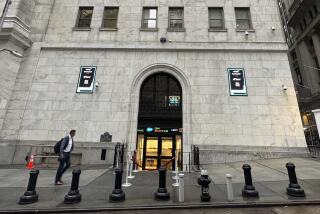Mexico’s Bolsa Surpasses 3,000 to Hit Record High
MEXICO CITY — Investors are returning to Mexico, spurred by a renewed fascination with emerging markets in general and optimism that the Mexican economy in particular--whose painful 1995 retraction rippled throughout the world--is showing signs of recovery.
Mexico’s most widely followed stock index, on news of another decline in interest rates, blew past the 3,000 level Wednesday to score a record high. Other Latin American stocks--slammed last year in the weeks following Mexico’s confidence-shattering peso devaluation--surged as well.
“You are getting an enormous move back into the [Latin American] region,” said Geoffrey Dennis, emerging-markets investment specialist with Bear, Stearns & Co. in New York.
But danger signs remain plentiful. Mexico is coping with a gravely disabled banking system, moribund consumer sales and high inflation. And investors and the public alike have been repeatedly disappointed by Mexico’s failures.
Dennis said the Bolsa--which has been regaining ground since March and surged 35% since Nov. 14--has climbed too far too fast. Mexican stocks could see a correction triggered by any further peso devaluation, he said.
“We’re getting ahead of the game in Mexico,” said Dennis, whose firm predicts the peso will fall to as low as 10 to the dollar this year and that inflation could match 1995’s rate of 50% and not dip to 20% as projected by the government.
Still, many analysts and investment managers are coming around to the belief that Mexico will emerge from its yearlong recession and show modest growth in 1996.
The latest cause for optimism was Tuesday night’s weekly pricing of the cetes, the bellwether short-term treasury bill to which many consumer and commercial loan interest rates are tied. The rate fell to 44.70%, down 2.11 percentage points from the week before and down from as high as 59.99% in mid-November.
Such indicators, and signs of a more stable peso, boosted the Mexican Bolsa to a record close Wednesday of 3,004.78, up 75.35 points, or 2.57%, on the day. On Tuesday, the Bolsa registered a 5.4% gain, the largest daily rise ever.
Meanwhile, Argentina’s main stock index rose 4.3% on Wednesday and Brazil’s rocketed 6.6%.
Earlier this week, U.S. Treasury officials said Mexico’s “critical period has passed” and they endorsed Zedillo’s forecast that the Mexican economy will grow by about 3% in 1996. That would be a significant turnaround from 1995, when the total output of goods and services shrank 7%.
The deep recession resulted from Zedillo’s drastic measures taken to rebuild dwindling foreign reserves. The measures included brakes on spending, imports and credit, steps now applauded by the financial community but decried by Mexican citizens suffering from job losses and high inflation.
The United States has a vested interest in a Mexican recovery, since the Clinton Administration led a $50-billion international bailout for Mexico last spring and desperately wants to avoid similar outlays or political repercussions in this presidential election year.
Another encouraging sign is that the peso has stabilized over the last two weeks, trading in a range of 7.5 pesos to 7.72 pesos to the dollar, a central bank spokeswoman said. On Wednesday, the peso closed at 7.57, stronger than Tuesday’s close of 7.67, she said.
That stability has not come without costs, however. Last week, Mexico’s central bank intervened for the fourth time in six weeks to buy pesos on international markets to bolster its value.
Still, several analysts said Wednesday that they have more confidence in the peso and other elements of the economy.
“I just visited Mexican companies that account for 60% of the Mexican stock market and I do feel optimistic” based on those companies’ hiring and expansion plans for 1996, said Josephine Jimenez, managing director and emerging-markets specialist at Montgomery Asset Management in San Francisco.
Those firms’ growth-oriented plans for 1996 lead Jimenez to think that Mexico’s economy is “stronger than the official figures indicate.”
“The peso has firmed, and that’s positive for the economy because it means lower interest rates and debt burdens [for consumers and businesses]. And lower debt burdens augur better for growth,” said Richard T. Saler, director of international equities at Lexington Management in New Jersey.
Moreover, investors who made big profits on U.S. stocks in 1995 “are looking for other areas to seek out, and emerging markets that have under-performed for two years are a candidate,” Saler said.
(BEGIN TEXT OF INFOBOX / INFOGRAPHIC)
New Year’s Surge
Major and emerging markets alike have surged during the first two trading days of 1996. Two-day percentage gain (country / index):
Brazil/Bovespa: 8.9%
Mexico/Bolsa: 8.8
Argentina/Merval: 8.7
Peru/General: 3.4
France/CAC 40: 3.8
Germany/DAX: 3.3
Sweden/OMX: 3.3
Hong Kong/Hang Seng: 3.2
Switzerland/Market: 2.6
Australia/Ordinaries: 2.5
New Zealand/40: 2.5
Amsterdam/CBS: 2.5
Canada/TSE 300: 2.3
Singapore/Straits: 1.6
Venezuela/Capital: 1.3
Britian/FTSE-100: 0.7
Note: The first 1996 trading day in Japan is today.
Source: Bloomberg Business News
More to Read
Sign up for Essential California
The most important California stories and recommendations in your inbox every morning.
You may occasionally receive promotional content from the Los Angeles Times.










